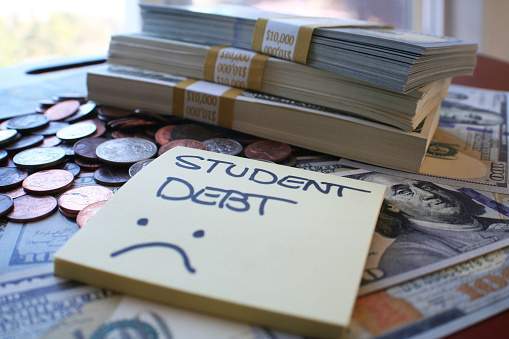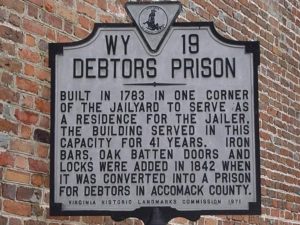Table of Contents
Explaining DOJ Guidance on Student Loan Forgiveness in Bankruptcy
Bankruptcy attorney explains new DOJ guidance from the Biden Justice Department to make it easier to get student loan forgiveness in bankruptcy
Yesterday, the Justice Department announced a new plan for student loan forgiveness in bankruptcy. The change could make it easier for people to eliminate — or “discharge”– student loan debt and to finally achieve student loan forgiveness and a fresh start in bankruptcy. Here is what it all means.
Current law of student loans in bankruptcy
The way things are right now, student loans in bankruptcy are almost impossible to eliminate. This is because Congress has added a requirement to show not just hardship (as many people in bankruptcy experience), but an undue hardship. Courts have interpreted this very strictly, and, as a result, it’s extremely difficult to discharge student loans in bankruptcy.
Does the Biden student loan initiative change bankruptcy law?

No, the Biden student loan forgiveness plan does not change the law. That would take an act of Congress, literally. Unlike other Biden administration plans on student loan forgiveness, which have faced legal challenges, this current plan doesn’t change existing law or otherwise change existing contract law. It’s merely guidance from the head of the executive branch to the Department of Justice, in the executive branch, on how it can try to steer student loan discharge bankruptcy cases.
So the Department of Justice decides student loan forgiveness?
Bankruptcy judges make the ultimate decisions about student loan dischargability. The Biden administration plan for student loans in bankruptcy doesn’t change that. It just intends to make it easier for student loan forgiveness in bankruptcy by issuing recommendations to the bankruptcy court.
Then what does the Dept of Justice have to do with bankruptcy?
The Department of Justice is very involved in the bankruptcy process. One might think that the IRS is the government agency that rules bankruptcy, because they’re both connected to money. However, the DOJ administers the bankruptcy process through various trustees.
Under the arm of the DOJ, the United States Trustee is the program which ensures the integrity of the bankruptcy program by prosecuting fraud, perjury, hidden assets, and other bankruptcy crimes. This is why the 341(a) Meeting of Creditors is so critical in every case, and why you should read my 12 crucial tips of do’s and don’ts before filing bankruptcy. But back to the DOJ.
In other words, the Department of Justice doesn’t decide student loans in bankruptcy. However, under the Biden process for bankruptcy and student loans, the DOJ and Department of Education (also in the executive branch) would review bankruptcy cases with student loan discharge issues. They would then give the bankruptcy judge the agencies’ thumbs-up or thumbs-down.

To get there, the DOJ and Dept of Ed would review a few key factors to determine whether they will recommend discharge to the bankruptcy judge, who ultimately makes the final decision. Bankruptcy judges are independent thinkers who deliberate, consider applicable law, and provide much thought to the cases and the unique facts before them. It’s not clear how much weight bankruptcy judges will give to this government recommendation, as each judge and each case is different.
The factors the Dept of Justice and Dept of Education reviews for student loan discharge
Consistent with current case law of Brunner v. New York State Higher Education Services Corp., 831 F.2d 395 (2nd Cir 1987), the agencies will review factors to determine if they will recommend discharge to the bankruptcy judge. It’s not all or nothing, as a partial discharge of student loan debt is possible. In re Saxman, 325 F.3d 1168 (9th Cir. 2003). These factors, in no particular order or weighting known at this point, are:
Present ability to pay
First, to evaluate this factor, DOJ attorneys will compare debtor’s expenses to two different things.
- To start off, the IRS has standards about what is considered reasonable expenses, and the Justice Department will compare those against the debtor’s bankruptcy petition and schedules.
- Next, assuming expenses are “reasonable,” Justice Department lawyers will compare debtor’s budget expenses to debtor’s income. If expenses exceed income, this step is satisfied.
Future ability to pay
Second, the Justice Department attorneys will then review various factors such as the debtor’s age, unemployment history, education status, and others. Assessing these variables, and based upon the debtor’s unique circumstances, the DOJ will try to predict whether it is likely that debtor’s financial position will stay the same, making it hard to repay student loans in the future. If they exist, certain variables are considered presumptions for future inability to pay.
These include if the debtor: is 65 years of age or older; has a disability or chronic illness which impacts earning potential; has been unemployed 5 of last 10 years; has failed to get a degree in the field the student loan debt was for; has had the student loan in “payment” status for at least ten years. These factors create a presumption, and as always, can be rebutted.
Good faith efforts
Third, the Department of Justice will look at whether the debtor has made a good faith effort to repay the debts. Did the person contact their student loan servicer or provider for repayment options? Did they try to repay the debt? Have they responsibly managed their expenses? Was there enrollment in an income-based repayment plan? If not, is there a good reason?
At least one of the following steps can be evidence to demonstrate good faith: making a payment; applying for a deferment or forbearance; applying for an IDRP loan or federal consolidation loan; responding to outreach from a student loan servicer or collector for the student loan debt; engaging with the Department of Education or one of their loan servicers about payment options, forbearance or deferment options, or loan consolidation; engaging with a third-party debtor believed would help them manage their student loan debt.
The good faith standard also looks at whether the debtor’s efforts to obtain employment, maximize income, and minimize expenses.
Assets of Debtor
Lastly, the Justice Department will analyze debtor’s assets. Just because a debtor happens to own a home or other real estate shouldn’t be slam-dunk evidence that there’s a lack of undue hardship. However, the DOJ can look at and suggest debtor liquidated assets which are not necessary for the support of debtor and their dependents’ support and welfare. Exempt property does not escape analysis, but Dept of Justice lawyers are cautioned about using it in an undue hardship analysis.
Can I reopen an old bankruptcy case and try to discharge my student loans under the new Justice Department guidelines?
The new procedures and standards are only for future cases. If you filed a bankruptcy with student loans in the past, you cannot apply these new guidelines to the old bankruptcy. Footnote 22 of the DOJ guidelines:
This memorandum applies only to future bankruptcy proceedings, as well as (wherever practical) matters pending as of the date of this Guidance. This Guidance is an internal Department of Justice policy directed at Department components and employees. Accordingly, it is not intended to and does not create any rights, substantive or procedural, enforceable at law by any party in any matter.
However, while you cannot open a old bankruptcy to apply this Justice Dept guidance, you may be able to try to discharge them in a new bankruptcy. As there are time requirements you have to wait between filing bankruptcy of various chapters, consult with a bankruptcy attorney to discuss your specifics.
Procedurally, does the new DOJ guidance on student loan bankruptcy automatically happen for all filings, or is action needed?
A few things have to happen to kick off the Biden student loan bankruptcy process. First, of course, the person, or debtor, has to file bankruptcy. Note that this Biden student loan program doesn’t change the median income eligibility requirements for Chapter 7 and the means test. Someone still has to qualify for Chapter 7 bankruptcy. The alternative would be a solution with the student loans in Chapter 13, which can still be beneficial.
Next, in the Chapter 7 bankruptcy, the student loan discharge process is not automatic. The debtor has to file additional paperwork, which is like suing the student loan lender in something called an adversary proceeding. It’s additional time and work, and if there is a bankruptcy lawyer involved (and there really should be), this will likely mean contracting for these extra services and an additional fee.
Finally, after the adversary proceeding has been filed and served on the student loan company, there is an attestation form the debtor completes and submits to the government. The Department of Justice and Education Department will then coordinate their resources to help determine their recommendation to the bankruptcy judge.
Results not guaranteed, but there’s hope
We really don’t know how successful this new Biden student loan bankruptcy guidance will be. You have to qualify for bankruptcy, then the government has to make a recommendation, and then a judge decides.
It’s ultimately unclear how cooperative the Department of Justice and Education Department will be with student loan borrowers under this new bankruptcy process. However, there is tremendous potential for the government applying the process with an eye on compassion and working with the borrowers who most need debt relief, a fresh start, and student loan forgiveness.
If you have student loan debt and think you fit the above factors and are in Los Angeles County, Orange County, or Ventura County, please contact me for a case evaluation. Thank you for reading.





